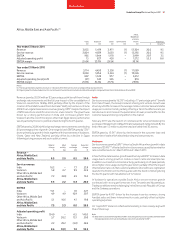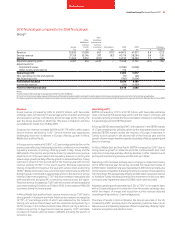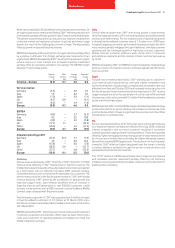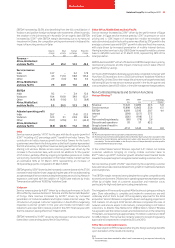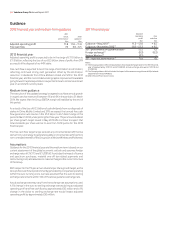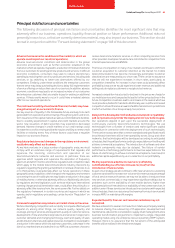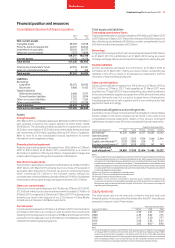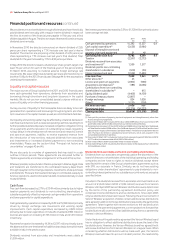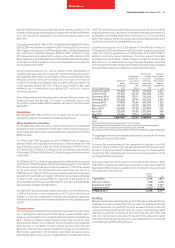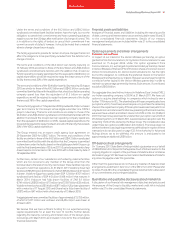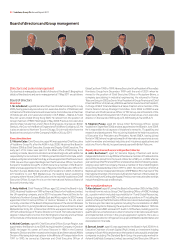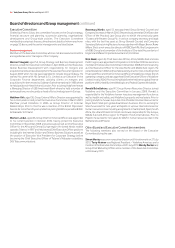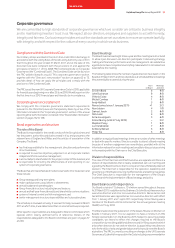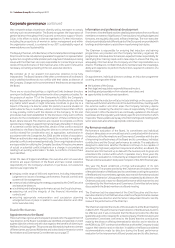Vodafone 2011 Annual Report Download - page 48
Download and view the complete annual report
Please find page 48 of the 2011 Vodafone annual report below. You can navigate through the pages in the report by either clicking on the pages listed below, or by using the keyword search tool below to find specific information within the annual report.46 Vodafone Group Plc Annual Report 2011
Principal risk factors and uncertainties continued
Changes in assumptions underlying the carrying value of certain
Group assets could result in impairment.
We complete a review of the carrying value of Group assets annually, or
more frequently where the circumstances require, to assess whether those
carrying values can be supported by the net present value of future cash
flows derived from such assets. This review examines the continued
appropriateness of the assumptions in respect of highly uncertain matters
upon which the valuations supporting carrying values of certain Group
assets are based. This includes an assessment of discount rates and long-
term growth rates, future technological developments, and timing and
quantum of future capital expenditure as well as several factors which may
affect revenue and profitability identified within the other risk factors in this
section such as intensifying competition, pricing pressures, regulatory
changes and the timing for introducing new products or services. Discount
rates are in part derived from yields on government bonds, the level of
which may change substantially period to period and which may be
affected by political, economic and legal developments which are beyond
our control. Due to our substantial carrying value of goodwill under
International Financial Reporting Standards, the revision of any of these
assumptions to reflect current or anticipated changes in operations or the
financial condition of the Group could lead to an impairment in the carrying
value of certain Group assets. While impairment does not impact reported
cash flows, it does result in a non-cash charge in the consolidated income
statement and thus no assurance can be given that any future impairments
would not affect our reported distributable reserves and therefore our
ability to make distributions to our shareholders or repurchase our shares.
See “Critical accounting estimates” on page 77 and note 10 to the
consolidated financial statements.
Our emerging market footprint may present exposure to
unpredictable economic, political, regulatory, tax and legal risks.
Political, regulatory, economic and legal systems in emerging markets may
be less predictable than in countries with more stable institutional
structures. Since we operate in and are exposed to emerging markets, the
value of our investments in these markets may be adversely affected by
political, regulatory, economic, tax and legal developments which are
beyond our control and anticipated benefits resulting from acquisitions
and other investments we have made in these markets may not be
achieved in the time expected or at all. For further information on legal and
tax proceedings see note 28.
We participate in joint ventures which expose us to operational
and financial risk.
We participate in a number of joint ventures, some of which we do not
control. Whether or not we hold majority interests or maintain operational
control in our joint ventures, our partners may have economic or business
interests or goals that are inconsistent with ours, exercise their rights in a
way that prohibits us from acting in a manner which we would like or they
may be unable or unwilling to fulfil their obligations under the joint venture
or other agreements. In particular, some of our interests in mobile licences
are held through entities in which we are a significant but not a controlling
owner. Under the governing documents for some of these partnerships and
corporations, certain key matters such as the approval of business plans and
decisions as to the timing and amount of cash distributions require the
consent of our partners. In others these matters may be approved without
our consent. We may enter into similar arrangements as we participate in
ventures formed to pursue additional opportunities. Although we have not
been materially constrained by our participation in joint ventures to date, no
assurance can be given that the actions or decisions of our joint venture
partners will not affect our ventures in a way that hinders our corporate
objectives or reduces any anticipated cost savings or revenue enhancement
resulting from these ventures.
Expected benefits from investment in networks, licences and new
technology may not be realised.
We have made substantial investments in the acquisition of licences and in
our mobile networks, including the roll out of 3G networks. We expect to
continue to make significant investments in our mobile networks due to
increased usage and the need to offer new services and greater
functionality afforded by new or evolving telecommunications
technologies. Accordingly, the rate of our capital expenditures in future
years could remain high or exceed that which we have experienced to date.
There can be no assurance that the introduction of new services will
proceed according to anticipated schedules or that the level of demand for
new services will justify the cost of setting up and providing new services.
Failure or a delay in the completion of networks and the launch of new
services, or increases in the associated costs, could have a material adverse
effect on our operations.
Our business may be impaired by actual or perceived health risks
associated with the transmission of radio waves from mobile
telephones, transmitters and associated equipment.
Concerns have been expressed that the electromagnetic signals emitted
by mobile telephone handsets and base stations may pose health risks at
exposure levels below existing guideline levels and may interfere with the
operation of electronic equipment. In the event of national governments
responding to public concern with the imposition of more stringent
exposure limits, our costs may be increased. In addition, as described under
the heading “Legal proceedings” in note 28 to the consolidated financial
statements, several mobile industry participants including Verizon Wireless
and ourselves have had lawsuits filed against us alleging various health
consequences as a result of mobile phone usage including brain cancer.
While we are not aware that such health risks have been substantiated,
there can be no assurance that the actual or perceived risks associated with
radio wave transmission will not impair our ability to retain customers and
attract new customers, reduce mobile telecommunications usage or result
in further litigation. In such event, because of our strategic focus on mobile
telecommunications, our business and results of operations may be
more adversely affected than those of other companies in the
telecommunications sector.
Our business would be adversely affected by the non-supply
of equipment and support services by a major supplier.
Companies within the Group source network infrastructure and other
equipment, as well as network-related and other significant support
services, from third party suppliers. The withdrawal or removal from the
market of one or more of these major third party suppliers could adversely
affect our operations and could require us to make additional capital or
operational expenditures.
Our business could be adversely affected by disruptions to our
telecommunications networks.
We are dependent on the secure operation of our telecommunications
networks and attacks on critical infrastructure, or disruption of our
networks caused by other factors beyond our control, pose an increasing
threat. As the importance of mobile communication in everyday life, as well
as during times of crisis, increases and the volume of personal and business
data being communicated and stored by network operators grows,
organisations and individuals look to us to maintain service and protect
sensitive information. Any significant interruption in our service or in our
ability to protect sensitive information, whether caused by acts of terrorism,
industrial action, natural disasters, political unrest or otherwise, could have
a material adverse effect on our revenue and our reputation.



